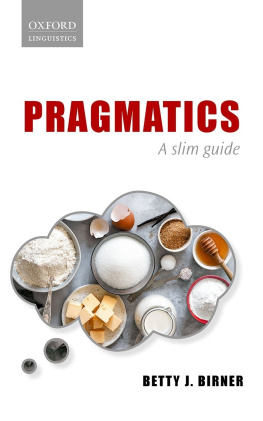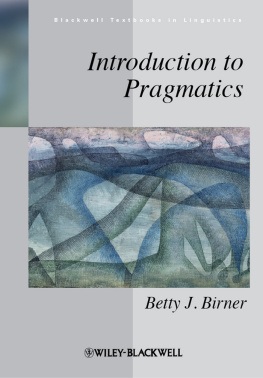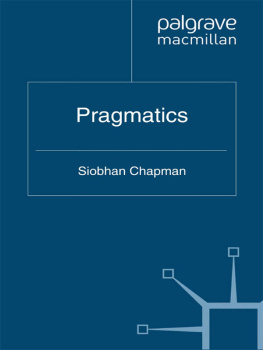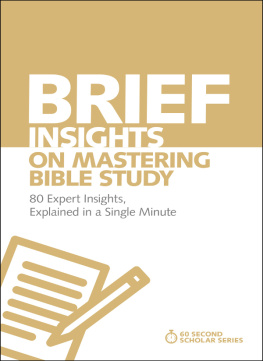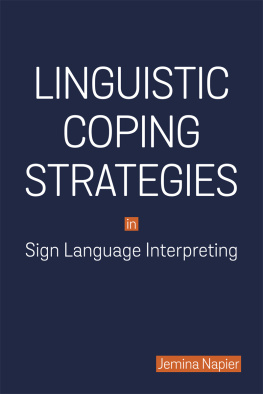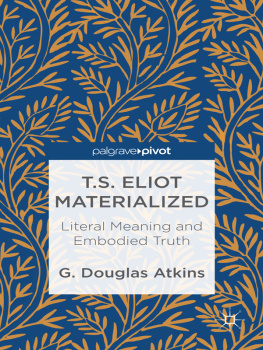I am grateful to Larry Horn and Gregory Ward for helpful comments and discussion, and especially to Jeff Kaplan for extensive, thorough, and deep comments on every chapter. I am grateful to Jeff Einboden for discussions that remind me how much fun research can be. I thank Shahrzad Mahootian both for helpful discussions and comments, and for saving my sanity on innumerable occasions.
I thank two anonymous reviewers for comments that have vastly improved this bookespecially Reviewer 1s twelve pages of single-spaced comments. I dont know who you are, but Im grateful.
Finally, and always, I thank Andy and Suzanne, my husband and daughter, who put the joy in my life.
If youve given it any serious thought, you know that there can be a big difference between what you say and what you actually mean by it. To take a simple example, people rarely state requests forthrightly; instead, they hedge their requests in a variety of ways:
(1) 
Instead of stating the request outright, as in () is literally a request for the book. Its a curious situation: Weve developed a wide range of ways to make someone understand us as having asked them for a book when we havent literally done so at all. What on earth is going on?
Whats going on, simply stated, is pragmatics. Pragmatics is the field of linguistics that studies meaning in contextspecifically, how a hearer understands another persons intended meaning based on what theyve said and the context in which theyve said it, and how speakers craft their utterances with that in mind. In short, pragmatics is the study of the relationship between what is said and what is meant, and between what is meant and what is understood.
As Reddy (1979) observes, the English language has a pervasive metaphor in which we simply put our meaning into words, then convey it to the hearer, who gets it (or doesnt get it, or maybe it goes right past them or goes over their head). Reddy calls this the Conduit Metaphor. But, he points out, the metaphor is misleading: My meaning is never conveyed out of my head and into yours; instead, communication is a complicated and collaborative process by which a speaker encodes meaning into a series of sounds (or signs, in signed languages, or written symbols), which in turn serve essentially as instructions to the hearer for building a corresponding set of ideas in their own mind. And because the hearers mental world is inevitably different from the speakers mental world, the meaning that gets constructed will inevitably differ slightly as well. (Imagine I tell you I have a cat. The cat you imagine will differ in innumerable ways from the cat being imagined by any other person reading this book, and from the cat that I have in mind.)
As we have noted, pragmatics is a field of linguistics. Linguistics, in turn, is the scientific study of language. The scientific part is important: Because its scientific, linguistics is descriptivewhich means that linguists try to describe the rules that govern our language use. You may be familiar with rules like dont use a double negative and dont end a sentence with a preposition, but those rules are prescriptive, not descriptive; they prescribe what someone thinks you should do. A descriptive rule describes what you in fact do. A descriptive rule of English might say, for example, that a determiner like the goes in front of a noun like cat to result in a phrase like the cat. No English speaker would ever say *cat the. (The asterisk indicates that its ungrammatical in the descriptive sense that speakers dont do itnot in the prescriptive sense that teachers tell you not to do it.) Linguists describe the workings of language and its parts in much the same way that botanists describe the workings of plants and flowers, and geologists describe the workings of minerals and tectonic plates.
Linguistics has various subfields: syntax, for example, is the study of sentence structure and explains facts such as why you cant say *cat the in English. Semantics, which well talk about briefly in this chapter, is the study of literal, conventional meaningfor example, the meaning of the word cat. Its the aspect of meaning that speakers of a language share, more or less; for example, although well all picture a slightly different cat, English speakers in general agree on what the word cat means. That meaning is conventional; we share it by tacitly agreed-upon convention. Pragmatics, on the other hand, covers the vast amount of meaning that goes above and beyond semantics. Its what gets us from Would you mind giving me that book? to the interpretation that the speaker is requesting the book. Its what takes us from what the speaker has said to what we think they actually meant by saying it right here, right now, in this shared context between these people. Its the difference between convention and intention.
For starters: Some basic terminology
One concept that is crucial to the linguistic study of meaning is truth. To state the obvious, something is true if it accurately describes the world. Is all dogs have tails true? Well, check the world. If theres a dog without a tail, then its not true that all dogs have tails. But that means truth is relative to a world. And while we live in a pretty great world, there are certainly other ways the world could have been. It would have been possible to have a world in which all dogs have tails; a world thats exactly like ours except that all dogs have tails is a

